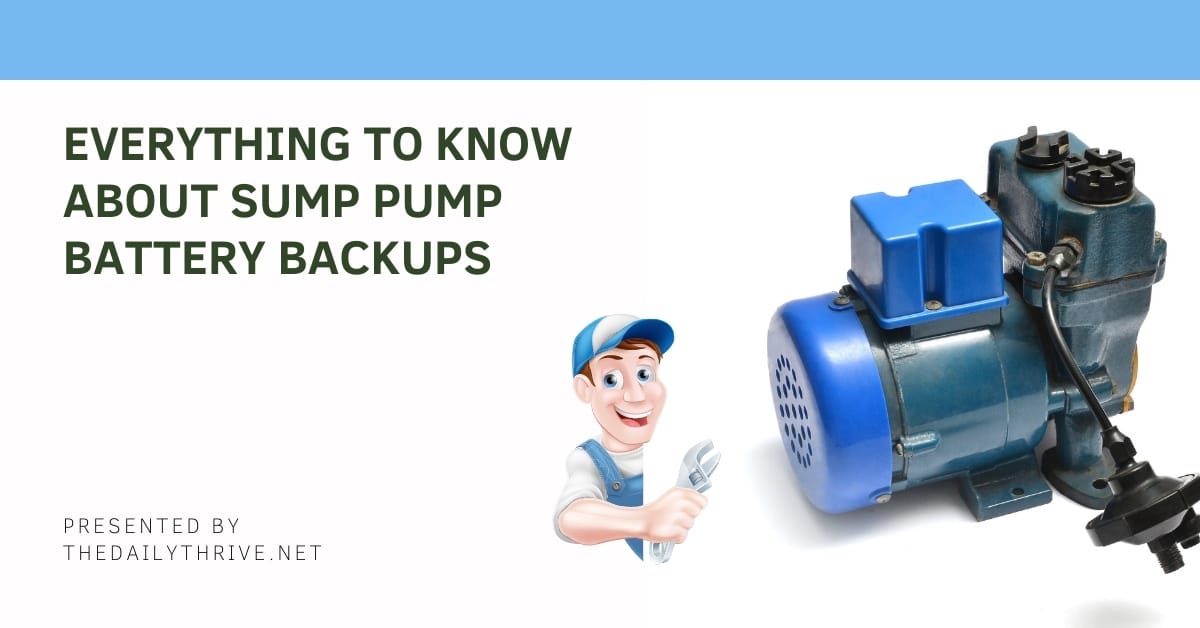Most sump pumps rely upon mains electricity to keep the basement of a house dry and flood free. The most common times you can experience a power outage are during or shortly after a heavy storm. This is the time when your sump pump should be working its hardest. This is where a sump pump battery pack can come in handy, potentially saving your basement from a very expensive and stressful cleanup operation.
If you already have an existing sump pump, most likely, it is an Alternating Current (AC) powered pump. You will need either a supplementary Direct Current (DC) powered pump for battery power or a pump that can be powered by AC or DC. This type will switch automatically from AC power to battery backup power when a power failure occurs.
Adding a backup battery-powered sump pump to your house will give you peace of mind knowing that a flood will not catch you unawares and a basement filled with water. Suppose you build a new house or basement and install a sump pump system from scratch. In that case, you can opt for a combination type pump, which contains both a primary pump and a backup-powered pump.
Backup sump pumps can also be auxiliary units to provide additional pumping flow during large water volume events, like a severe rain storm or rapid snow melts. In this case, installing a float switch in the circuit will allow the second pump to kick in when water reaches a certain level, usually above the level set for the mains sump pump to turn on.
What is a sump pump?
Sump pumps are a type of impeller pump usually preinstalled in any basement. They are connected to the sump basin of your basement (hence the name). They can be either a pedestal-mounted type or a submersible type. A submersible sump pump is mounted completely inside the sump itself. In contrast, the pedestal pump has the motor portion mounted above the sump.
Sump pumps can also be manual or automatic operation types. Newer smart automatic pumps are being introduced, which will send a text or email to your smartphone when the pump has an emergency, such as a power failure.
The purpose of a sump pump is to stop dampness within the basement or actively pump water away to avoid the risk of flooding after a heavy storm or due to the presence of natural groundwater (if your basement is below the water table). They will remove the water from this sump basin and pump it to an area where it will no longer cause a problem.
What a Battery Backup for a Sump Pump Is
A battery backup system for a sump pump is made up of a sump pump, a 12-volt marine battery, and electrical and plumbing parts. The system works as a backup for your main sump pump. So, backup systems aren’t all that are used. Instead, they are used along with another system that works.
Suppose the main sump pump system fails for some reason, like not having enough electricity. In that case, the battery backup system takes over. Most systems tell you that your home is now running on battery power by sounding a loud alarm.
With a smart battery backup for your sump pump, you can get a message on your phone when the backup system takes over from the main system.
Sump Pump Battery Backup Types
Sump pump battery backup comes from either traditional acid-type batteries or Deep Cycle marine batteries. The marine batteries are maintenance-free and do not require topping up water periodically, like the acid batteries. If you can afford it, the deep-cycle marine battery is preferable. Both types used in backup systems for sump pumps are 12 Volt.
Rather than trying to buy, match and assemble all the components of a backup system yourself, it is easier to buy a complete, ready-made system kit. The kit will usually include the sump pump, battery, and controller if it is a separate unit from the pump. You can also buy an alarm to hook up to the pump to alert you when it is going to battery backup mode.
Sump Pump Battery Backup vs. Backup Generator
There are two main backup systems to power sump pumps if your primary pump fails during a power outage – a sump pump battery pack and a backup generator for your sump pump. The most common method that tends to be used is a battery pack backup sump pump that will get to work if your primary pump fails or is disconnected from an electrical supply. These pumps usually run off a 12V battery and can be recharged after use.
On top of this, sump pump battery backup packs are a relatively cheap option when considering what backup option to use for your sump pump. However, you must also consider that if the battery pack is in use, you will have to keep an eye on it – batteries only have finite power! As a battery-powered sump pump only has a limited use time, if a particularly long storm grips your hometown, you could still be in trouble.
Your other backup power option is to install a generator in your house to keep your power going. Of course, a generator will keep more than just a sump pump going, and you will be able to use it to power any electrical products you want to keep power in case of a blackout.
While you may be thinking that straight away, a generator is, therefore, a better option because of this, there is one final piece of information to take into account: generators are very expensive. Depending on your individual needs, a typical generator will likely set you back around $3,000 – $7,500.
How to install battery backup sump pump?
Before your sump pump installation goes ahead, you will need to clear everything out of your basement and be prepared to put in some hard, time-consuming work. You will need to allocate an area in your basement to pull up and install your sump pump, usually around 4 x 4 ft.
The next step is to start digging the hole that your sump pump will sit in, the depth of which will depend upon the size of your sump pump. However, a 35-inch hole should be deep enough. Before you sit your sump pump in this pit, you must line it with thick plastic sheeting and add gravel that the pump will be placed on. Remember to check what device you are using, as there are two types of sump pumps: pedestal and submersible.
Submersible sump pumps are fairly self-explanatory – their motors are designed to be water-submersed. However, pedestal pumps are slightly different. These pedestal sump pumps will need their motor to sit outside the sump pit you have dug while the pump stays in the pit.
This is a fairly time-consuming task, and you may wish to rent out more expensive, quality tools to get the job done in a cleaner and more professional manner. This is, of course, entirely up to you and simply my own personal recommendation. If you prefer to do the job by hand, that is your choice.
The actual use of the sump pump depends upon the unit you have purchased. However, the majority nowadays are automatic, depth-activated pumps – float-activated submersible devices. This means that the sump pump will begin working when the water level in the pit you have dug has reached a certain point.
How much does it cost to install a sump pump battery backup?
Sump pump battery backups cost between $500 and $1,250, with an average price of $1,000. Installing the system yourself will cost between $175 and $750.
Other Flood Prevention Methods
The main thing you need to consider when looking at preventing floods in your basement is to make sure your property is fully waterproof. Several methods fall under this waterproofing category, and these can be divided into two sub-categories: exterior and interior waterproofing.
Interior waterproofing can be achieved by introducing something called a ‘french drain‘ below your basement floor. When this system is used with a water vapor barrier within your walls, water can be directed to the french drain and help keep mold and dampness away from the basement.
To carry out exterior waterproofing on your basement, you will be required to excavate the foundations of your property to reveal the exterior walls of your basement. Upon achieving this, waterproofing your basement begins with a spray-on polymer layer on the outer walls.
An outside drain tile system is implemented outside as well, that water is directed to from the membrane applied to the outside walls. The process ends with a compacted layer of soil applied to the side of the house, which slopes away from your property.

